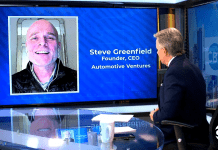At NADA 2019 We spoke with John Fitzpatrick, President and CEO of Force Marketing to discuss what the Force team has planned for 2019.
To see more interviews from the Force Marketing team or to watch our full coverage of NADA 2019, visit us at CBTNews.com.
Video Transcript:
Jim: We’re joined by Mr. John Fitzpatrick, who is the president and CEO of Force Marketing. Welcome to CBT. Talk to us about some of the things that’s going on at Force this year.
John:We’ve got a lot of great stuff going on. First of all, what a great industry we’re in, right? I mean, the positivity being shared around this hall has been fantastic. Everyone is really starting to think about their business in terms of how do we use data in a bigger way to get more effective with not only our marketing dollars, but how efficient we are with running our dealerships and profitability and scalability, and just … We’re having really, really good, deep, meaningful conversations with all of our dealer partners. And quite honestly, the vendor partners as well. Just really, really good stuff happening.
At Force Marketing and Helix Technologies, we are really focused on taking the data that’s available … Not only the first party data that a dealer has, but all of the third party data that can be brought in, to really give a good understanding of a marketplace, so that we can be super-targeted, really personalized in our messaging and our targeting on behalf of the dealer to the marketplace. And then make sure that we’re automating all of that information in a dynamic way, and then making sure that we’re showcasing attribution so that we can be looking at the efficacy of all of the mediums.
Jim: But dealers right now are so focused on keeping their expenses down, and advertising seems to still be one of those areas that just seems to get $700 a car, $800 a car. Some dealers report $1,000 a car. And I know you guys are working on some cool things to not only hit the target and bring the customer in, but bringing the cost of that acquisition of that customer way, way down, right?
John: That’s right. That’s right. Bringing it way, way down. And the other thing that we’re helping them really analyze is their closing percentages, right? Internet leads, for a very long time … in my opinion, in our opinion at Force … have been overlooked. We’re okay with a 15% closing ratio on internet leads. And that would maybe be a good dealership. We know dealerships that say, “Look, internally we’re more like 7% or 8%.” Even if you’re 20% or 25%, folks nowadays that are spending a tremendous amount of time online … J.D. Power will tell you it’s about 14 hours. Google tells us it’s across a hundred different touch points.
They’re telling us what they’re … They’re giving us all the information on their trade-in, they’re spending a tremendous amount of time looking for financing. They’re spending all of this time online, and then we’re okay with only closing them at 15%? So-
Huge disconnect there. And so one of the things that our technology is really bringing to light is … In real time, by the way … Is the analytics behind … Let’s raise up that level, right? And let’s do a better job of really closing at a higher percentage, and then have some processes built in on the backend for the folks that maybe are lost or we feel like fell out of market.
One of the things that we’re also looking at is that many dealers will say, “Well after 14 days, we call that deal dead.”
But we’re finding that 40% of those consumers are still in-market. They’re not dead. They’re still shopping. And if you communicate with them in a personalized way, and you do it frequently when they’re in-market and showing in-market behavior, then you can be very, very effective at closing what you then considered lost leads. So-
Jim: What do you tell your clients that target should be, if not 15% or 25%? If I’m a client of Force, I’m a Toyota dealership in a major metro, what should I be looking to close?
John: Again, if we’re looking at the internet leads of today … And I just walked you through what the consumer’s going through just to submit that lead. I don’t know; why is it not 80%, right?
But obviously, to go from 15% to 80% would be very, very tough. A lot of our dealers, though, are starting with, “Let’s double that. Let’s take it to 30%.” And then once we do a good job there- … Let’s go to 40%, right? And let’s really be mindful around closing at a higher rate. And then to your point earlier, it’s the second business expense that a dealership has, is their advertising budget.
So our focus in a lot of our partnerships is how do we decrease that by cutting out a lot of the waste? Getting more targeted, spending in the right areas across the customer journey, and then not just closing at a higher rate, but making sure that we get a higher market share on that same ad expense. And our dealer partners are really experiencing great results out of that mindset.
Jim: So it’s a question, really, about spending the same kind of money that a dealer may be spending in digital, but getting a way better result for the investment they’re making.
John: Yeah. Or in some cases you can decrease it, right? Just by measuring, over and over and over, the effectiveness and looking at it as an investment versus an expense. Because the first question we have with a new dealer is [inaudible 00:05:01] says, “Well, first of all, how much do you spend in your marketing each month.
“Well, we’re spending $80 grand a month.”
“Great. Do you look at that as an investment or an expense?”
That’s a telling question for us, because if it’s an expense then it’s purely a line item that you’re always just looking at as a way to cost and reduce. If it’s an investment, you’re looking at it from the standpoint of ROI, and where was the best ROI. And we like to think of ourselves much like you would talk with your stock trader or your financial advisor about where to spend your portfolio-
You should be looking at your ad expense the same exact way, right? And all the data points that tell us where the best ROI is going to come from. And that’s what really is at the core of Helix, and at the core of the team at Force Marketing, and I think has been a big reason why we’ve had great success over the last few years.
Jim: So, for the people that are listening right now that are not as familiar with Helix, talk to us a little bit about what Helix is all about and the impact that it has in a dealer’s marketing strategy.
John: Helix is a very robust business intelligent tool that sits on top of a dealer’s DMS and CRM, makes all of that data actionable through marketing. We think about it very simply in three A’s. First is audience, right? We want to make sure that we’re segmenting the audiences that they have, scoring those audiences based on our behavioral information and our tracking. That’s a proprietary piece of our technology that’s super impactful, that gives us information around how likely they are to do business with the dealership, not just on the sales side, but on the service side as well. Once we’ve identified the different audience segments, we can then automate … Which is our next A, automation. We can automate dynamic offers in real time to those folks, with messaging that is inline with what they were searching for on the dealer site.
Our third A is attribution. Making sure that we’re reporting on how effective those ad dollars were, in a very clear attribution metric, in a transparent way where anybody can log on, whether you’re the CMO of the dealership group, the GM, the GSM, or the ad partner, internet director, whoever, log on and see how effective those ad dollars are.
So in three A’s … audience, automation, and attribution … that’s how we sum up, really the focus of the technology Of Helix.
And then the folks at Force Marketing are pulling the levers behind that, right? Helping dealers, from a consultative approach, use that technology as effective as possible. Because here’s the other thing about technology: you can have the best technology in the world. If you don’t have good people that understand how to use that technology, it’s all for naught. And so our team is really a support team of teaching and educating our dealer partners on how to utilize the technology. And hopefully one day they can just use it themselves, with their internal teams.
Jim: What you just said, support. We talked to a lot of dealers here at CBT, as you know, and they’ll say they’ll bring on a vendor and, man, the person talked a great show in the conference room. But when push came to shove and where the rubber meets the road is really in that support, right, after you sign the contract.
John: It’s a big piece of it. There’s no doubt.
Jim: So talk to us about the staff that you’ve got at Force to help dealers on the battlefield, as they need it.
John: Yeah, absolutely. And it’s a big piece of our winning formula. It’s our client success team. They are the marketing directors behind the scene. They work in a pod environment. And so a pod is much like a team. We’ve taken one person from every area of the business … creative, strategy, technology, right? And we’ve brought them into a pod, and they work on a dedicated book of business. They’re all led by our VP of lient success, who was formerly with Lithia Motors, and, prior to that, a lot of other organizations. And what she’s brought to the table is a lens of what our dealers are looking for from their vendor partner. As agency partners, as technologists, doing all these great things, who on our executive team has sat in the seat of our client, to give us the lens of what is needed, what are they looking for, what’s important to them, how should the conversations go? And our team has really benefited by Allison Centore coming aboard and bringing that lens to the team.
And our dealer partners have already seen a big impact on that as well. And so we’re really experiencing good success from that.
Jim: And for the dealers that are listening, if you had to tell them to focus on one area in 2019 as it relates to their marketing, what would that one area be?
It’s going to sound repetitive, but it is the importance of really focusing on your data, and your current customer base, and all of the nuances within that, because that unlocks the key … or unlocks all that is behind the data, which is spending effectively, right? And really creating communication channels in a personalized way so that you can sell and service in your markets a lot better. So it really, truly does start with understanding that data is not just a key term thrown around. There are great vendors in here that have either built technology like us, or partnered with other technology that’s out there, and they’re creating a better environment for running their businesses.
So I would say that that’s where it starts. Now, there’s a lot that comes after that. Once you’ve identified that, “Yes, data is important. Yes, I have the right team,” then you can really get to the next level, which is running your business in a more efficient manner.
Jim: And it’s pretty safe to say that if you’re not paying attention to your data and your customers that’s in your database right now, somebody else is, right?
John: Oh, absolutely. Yeah, absolutely.
Jim: So you’re running as much of an offense as you are a defense, with regard to the data base that you’ve got, right?
John: That’s right. One of the other things that we’ve found to be really effective in communicating with our partners is having a mindset and having the conversation all around the outcome. So rather than getting caught up in all of the different metrics, right … And every single vendor can walk in on the same sheet of metrics and paint a different narrative on whether or not the store is doing good or bad or what you should focus on … And we’ve found that to just be time poorly spent, right?
What we would rather do … And here’s the other side of it, is whoever you’re speaking to at the dealership likely doesn’t want to have that conversation either. They don’t really … They’ve been told different stories around which metrics makes the most sense, and which ones to pay attention to, which ones not to pay attention to.
It is, it is. And there’s a lot of fear around it because it’s like, “Hey, I don’t do that. I know how to sell cars and I know how to service vehicles and I’ve got an operation to run and all of the things that go into running a dealership, and now I’ve got to understand technology and data and all this other stuff?”
I would say, find a partner that understands how to communicate with you all around your outcomes, right? Any GSM, any general manager, any dealer principal, if you just walk into them right now here and you say, “Hey, look, tell me what your three goals are at your store in new, in used, and in service.” They can tell you right off the top of their head. They don’t have to reference a spreadsheet, they don’t have to say, “Well, I’m not really sure.”
They’re going to tell you instantly, “I want to do X percent market share on new cars. I want to have a certain amount of volume on my used cars. I want to take it from 100 to 110. And I want to have a certain percent retention on service, or I want to hit a certain ROK.” Our entire team, our client success team, our technology is all built around achieving those outcomes.
Jim: Wow. So it’s really in line with what the dealer’s goals are, right?
John: Exactly, exactly.
Jim: And that’s the key to it. I mean, you’re going to have a happy customer if the marketing team is in line with what the goals are at the dealership, and you guys are doing this thing together, right?
John: That’s what we believe.
Jim: Yeah, for sure. Well, John Fitzpatrick, we want to thank you so much for joining us on CBT. It’s always a pleasure.
John: Thank you.
Jim: And hopefully, we’re going to have you back after the NADA convention, talk about some of the things that dealers are going to be faced with in the first quarter.










